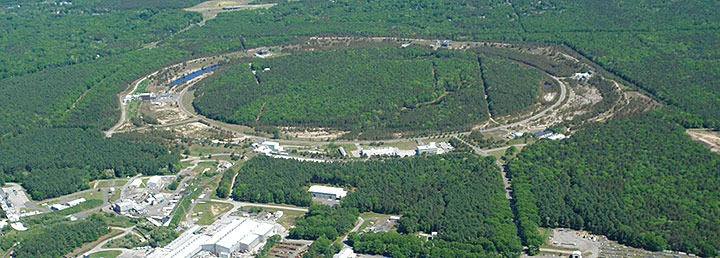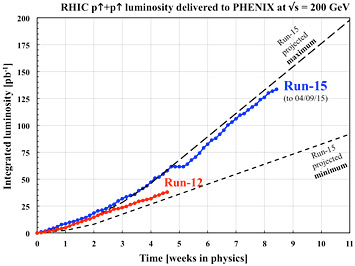Relativistic Heavy Ion Collider Smashes Record for Polarized Proton Luminosity at 200 GeV Collision Energy
Electron lenses and other accelerator improvements keep beams focused and compact to maximize collision rates and scientific productivity
April 14, 2015

An aerial view of the Relativistic Heavy Ion Collider, the only machine in the world capable of colliding beams of polarized protons—protons whose individual spins are aligned in a particular direction—to tease out how the protons' inner building blocks, quarks and gluons, contribute to proton spin.
 enlarge
enlarge
RHIC is producing more than twice as many proton-proton collisions per week during the current run as it did in 2012, the last run dedicated to polarized proton collisions.
UPTON, NY—The Relativistic Heavy Ion Collider (RHIC), a powerful particle accelerator for nuclear physics research at the U.S. Department of Energy's Brookhaven National Laboratory, just shattered its own record for producing polarized proton collisions at 200-giga-electron-volt (GeV) collision energy. In the experimental run currently underway at this two-ringed, 2.4-mile-circumference particle collider, accelerator physicists are now delivering 1200 billion of these subatomic smashups per week—more than double the number routinely achieved in 2012, the last run dedicated to polarized proton experiments at this collision energy.
"The increased luminosity will generate high volumes of data rapidly, giving us time to achieve several high-priority science goals in a single run at RHIC."
— Berndt Mueller, Brookhaven Lab's Associate Director for Nuclear and Particle Physics
The achievement is in part the result of a method called "electron lensing," which uses negatively charged electrons to compensate for the tendency of the positively charged protons in one circulating beam to repel the like-charged protons in the other beam when two beams circulating in opposite directions pass through one another in the collider (see sidebar).
"In 2012, these beam-beam interactions limited our ability to produce high collision rates," said Wolfram Fischer, Accelerator Division Head for Brookhaven's Collider-Accelerator Department. So the RHIC team commissioned electron lenses and a new lattice to mitigate the beam-beam effect.
"RHIC is the first collider to use electron lenses for head-on beam-beam compensation," Fischer said. "From what we see so far, the electron lenses appear to be doing what they were designed for."
The team also upgraded the source that produces the polarized protons to generate and feed more of these particles into the circulating beams, and made other improvements in the RHIC accelerator chain to achieve the higher collision rates (or as physicists call it, luminosity).
More collisions, more data, more science
"The increased luminosity will generate high volumes of data rapidly, giving us time to achieve several high-priority science goals in a single run at RHIC," said Berndt Mueller, the Associate Director for Nuclear and Particle Physics at Brookhaven Lab. "By allowing more science to be done in a fixed number of running weeks, the luminosity increase provides a richer return on the investments made by the nation in the science program at RHIC."
During the initial stage of the run, RHIC physicists are colliding high-energy 200 GeV polarized protons—protons whose individual spins are aligned in a particular direction—with another proton beam to tease out how the protons' inner building blocks, quarks and gluons, contribute to overall proton spin—a long-standing physics mystery. RHIC was the first machine to reveal that gluons play an important role in this intrinsic particle property. The new results will improve on the precision of those measurements. They will also allow scientists to study the coupling between the spin and momentum of the quarks.
With RHIC on track to another year of record performance, scientists are looking forward to a wealth of new insights from this year's data.
Research at RHIC, a DOE Office of Science User Facility, and upgrades to its infrastructure are funded primarily by the DOE Office of Science.
Brookhaven National Laboratory is supported by the Office of Science of the U.S. Department of Energy. The Office of Science is the single largest supporter of basic research in the physical sciences in the United States, and is working to address some of the most pressing challenges of our time. For more information, please visit science.energy.gov.
2015-11715 | INT/EXT | Newsroom









